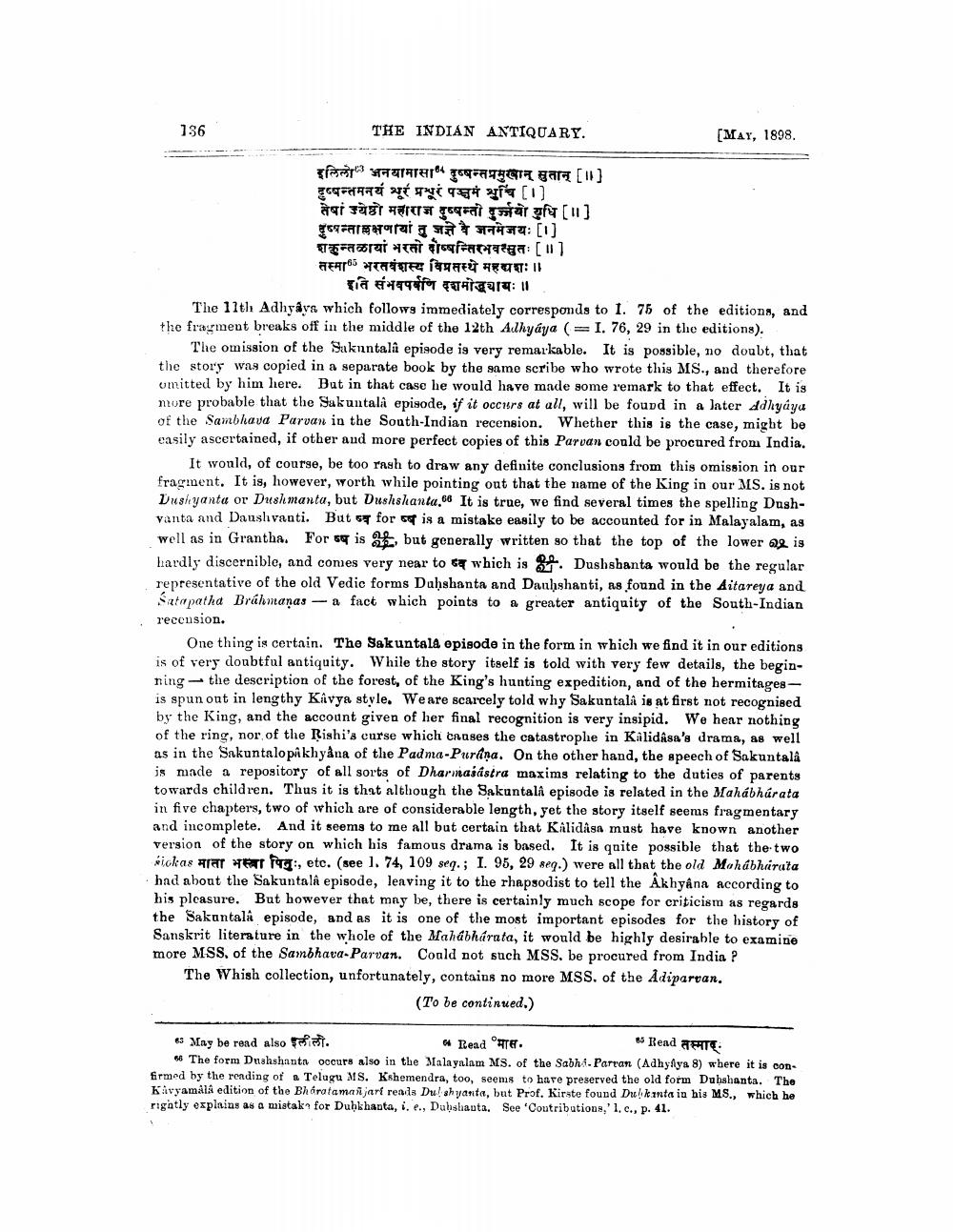________________
136
THE INDIAN ANTIQUARY.
[MAY, 1898.
TOATE 69Fatra gara [1] 26 26 yiqi fa [] तेषां ज्येष्ठो महाराज दुष्षम्तो दुर्जयो युधि [1] दुधन्तालक्षणायां तु जज्ञे वै जनमेजयः [1] शकुन्तळायां भरतो दोषन्तिरभवस्सुतः[॥] तस्मा भरतवंशस्य विप्रतस्थे महद्यशः ।।
इति संभवपर्वणि दशमोध्यायः ।। The 17th Adhyâys which follows immediately corresponds to 1. 75 of the editions, and the fragment breaks off in the middle of the 12th Adhyaya (= 1.76, 29 in the editions).
The omission of the Sakuntalî episode is very remarkable. It is possible, no doubt, that the story was copied in a separate book by the same scribe who wrote this MS., and therefore umitted by him here. But in that case he would have made some remark to that effect. It is more probable that the Sakuntala episode, if it occisrs at all, will be found in a later ddhyaya of the Sambhava Parvan in the South-Indian recension. Whether this is the case, might be easily ascertained, if other and more perfect copies of this Parvan could be procured from India.
It would, of course, be too rash to draw any definite conclusions from this omission in our fragment. It is, however, worth while pointing out that the name of the King in our MS. is not Dushyanta or Dushmanta, but Dushshanta.68 It is true, we find several times the spelling Dushvanta and Daushvanti. Buts for sef is a mistake easily to be accounted for in Malayalam, as well as in Grantha. For se is , but generally written so that the top of the lower ag is hardly discernible, and comes very near to 4 which is a Dushshanta would be the regular representative of the old Vedic forms Dahshanta and Danhshanti, as found in the Aitareya and Satapatha Brahmanas — a fact which points to a greater antiquity of the South-Indian recension.
One thing is certain. The Sakuntala episode in the form in which we find it in our editions is of very doubtful antiquity. While the story itself is told with very few details, the beginning the description of the forest, of the King's hunting expedition, and of the hermitagesis spun out in lengthy Kavya style. We are scarcely told why Sakuntala is at first not recognised by the King, and the account given of her final recognition is very insipid. We hear nothing of the ring, nor of the Rishi's curse which causes the catastrophe in Kalidasa's drama, as well as in the Sakuntalopakhyana of the Padma-Puriņa. On the other hand, the speech of Sakuntala is made a repository of all sorts of Dharmasastra maxims relating to the duties of parents towards children. Thus it is that although the Sakuntali episode is related in the Mahábhárata in five chapters, two of which are of considerable length, yet the story itself seems fragmentary and incomplete. And it seems to me all but certain that Kilidasa must have known another version of the story on which his famous drama is based. It is quite possible that the two kickas rare Trg, etc. (see 1. 74, 109 seq.; I. 95, 29 seq.) were all that the old Mohábharata had about the Sakuntal episode, leaving it to the rhapsodist to tell the Akhyana according to his pleasure. But however that may be, there is certainly much scope for criticism as regards the Sakuntala episode, and as it is one of the most important episodes for the history of Sanskrit literature in the whole of the Mahabharata, it would be highly desirable to examine more MSS. of the Sambhara-Parvan. Could not such MSS. be procured from India ? The Whish collection, unfortunately, contains no more MSS. of the Adipartan.
(To be continued.)
6 May be read also .
Read Te.
ta Read तस्मात् 46 The form Dushshanta occurs also in the Malayalam Ms. of the Sabhi-Parran (Adhyfya 8) where it is confirmed by the reading of a Telugu MS. Kshemendra, too, seems to have preserved the old form Dahshanta. The Kivyamåla edition of the Bharatamarijari reals Dul shyanta, but Prof. Kirste found Dulkinta in his MS., which he rigatly explains as a mistaka for Duh hanta, i.e., Dahshanta. See 'Coutributions, ' 1. c., p. 41.




